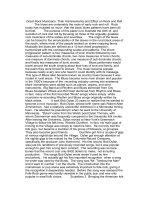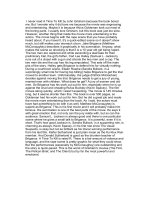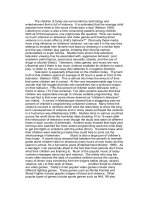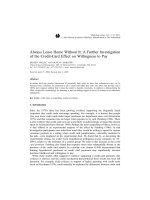Acute abdominal pain management, educational effect on time to analgesia
Bạn đang xem bản rút gọn của tài liệu. Xem và tải ngay bản đầy đủ của tài liệu tại đây (4.38 MB, 107 trang )
ACUTE ABDOMINAL PAIN MANAGEMENT:
EDUCATIONAL EFFECT ON TIME TO ANALGESIA
BY
MARY BETH WALDO
DOCTOR OF NURSING PRACTICE CLINICAL PROJECT
Submitted in partial fulfillment of the requirements for the degree, Doctor of Nursing Practice,
The College of St. Scholastica, May 2012.
Project Committee
Pam Bjorklund, PhD, RN, CS, C-NP
Chair
Melissa Ann Saftner, PhD, CNM, RN
Date
April 26, 2012
Sally Fauchald, PhD, RN
Chair, Graduate Nursing Department
UMI Number: 3519477
All rights reserved
INFORMATION TO ALL USERS
The quality of this reproduction is dependent on the quality of the copy submitted.
In the unlikely event that the author did not send a complete manuscript
and there are missing pages, these will be noted. Also, if material had to be removed,
a note will indicate the deletion.
UMI 3519477
Copyright 2012 by ProQuest LLC.
All rights reserved. This edition of the work is protected against
unauthorized copying under Title 17, United States Code.
ProQuest LLC.
789 East Eisenhower Parkway
P.O. Box 1346
Ann Arbor, MI 48106 - 1346
© Mary Beth Waldo 2012
ii
Dedication
To Joe, husband and best friend, the adventures continue. Thank you for all your love
and support.
iii
Acknowledgements
To my children Nick, Kate, Julie, and Tony who understand the sacrifices for education
yet still support the learning process.
To Deb, this is the fourth degree during which you listened, commiserated, and
supported. Your friendship is legion. Thank you for being the wonderful person you are.
To Rose and Lucinda who constantly bless me with the treasure of their friendship. Your
support throughout this process was invaluable.
To Joe Heimler, community partner, your calm and supportive manner model true
leadership. Thank you.
To the staff at Mayo Clinic Health System-Red Cedar, thank you for the support and
teamwork. We all know why Red Cedar is special. The facility grows and thrives because of the
people who work there.
To Pam Bjorklund, thank you for your knowledge, support, and guidance.
iv
Abstract
An audit of 100 charts of patients who presented to an urgent care and emergency department
(UC/ED) with severe, acute abdominal pain (AAP) was conducted to determine the percentage
of patients receiving analgesia and the wait times to ordering and administration of analgesia.
Subsequently, a policy for AAP management was proposed for the UC/ED, and UC/ED staff
received an educational intervention on AAP management. Post-education, an audit of 50 charts
of patients presenting to UC/ED with AAP was conducted. The post-education outcomes of
better AAP management as measured by decreased wait times to analgesia orders and
administration were not statistically significant compared to the pre-intervention outcomes.
Management of AAP improved in terms of the percentage of patients receiving analgesia for
AAP, increasing from 48% to 66%.
v
Table of Contents
Dedication ................................................................................................................................... iii
Acknowledgements ..................................................................................................................... iv
Abstract .........................................................................................................................................v
Chapter I: Executive Summary .....................................................................................................1
Statement of the Problem ..................................................................................................1
Purpose of the Project .......................................................................................................2
Significance for Outcomes ................................................................................................4
Theoretical Rationale Guiding the Project ........................................................................5
Project Stakeholders and Community Partner ..................................................................6
Summary ...........................................................................................................................7
Chapter II: Literature Review .......................................................................................................9
Literature Related to the Problem .....................................................................................9
Definitions and Background ...........................................................................................12
Identifying Stakeholder Barriers .....................................................................................17
Literature Related to Theoretical Rationale ....................................................................24
Literature Related to Outcomes ......................................................................................27
Summary .........................................................................................................................31
Chapter III: Implementation .......................................................................................................32
Introduction .....................................................................................................................32
Objectives .......................................................................................................................32
Setting and Population ....................................................................................................33
Implementation ...............................................................................................................34
vi
Design and Data Collection ............................................................................................35
Proposed Budget and Timeline .......................................................................................40
Summary .........................................................................................................................40
Chapter IV: Project Findings ......................................................................................................42
Introduction .....................................................................................................................42
Data Analysis ..................................................................................................................42
Results .............................................................................................................................43
Systems Changes ............................................................................................................47
Summary .........................................................................................................................49
Chapter V: Project Summary ......................................................................................................51
Recommendations for System Change ...........................................................................51
Implications for Maintaining Change .............................................................................56
Plan for Dissemination of Results...................................................................................56
Summary .........................................................................................................................57
References ...................................................................................................................................58
Appendices:
A. Data Collection Template .........................................................................................71
B. AAP Educational Intervention Handout ...................................................................73
C. AAP Presentation Objectives ....................................................................................79
D. Abdominal Pain Management Key Points ................................................................81
E. Acute Abdominal Pain Algorithm ............................................................................83
F. Nurse Pain Assessment Scripting Guidelines ...........................................................85
G. Proposed Timeline for AAP Project .........................................................................87
vii
H. Logic Statement for AAP Project .............................................................................89
I. Work Breakdown Structure for AAP Project ...........................................................91
J. Institutional Board Review Approval .......................................................................93
K. Institutional Board Review Addendum ....................................................................95
viii
List of Tables
Table
Page
1.
Chi-square Test Results of Education and Analgesia .....................................................44
2.
Education and Analgesia Cross-tabulation .....................................................................44
3.
Pre- and Post-education and Ordered Analgesia Results ................................................45
4.
Pre- and Post-education and Ordered Analgesia Mean Wait Times...............................45
5.
Pre- and Post-education and Administered Analgesia Results ......................................46
6.
Pre- and Post-education and Administered Analgesia Mean Wait Times ......................46
7.
Pre- and Post-educational Intervention Data Comparisons ............................................47
ix
List of Figures
Figure
Page
1.
Press Ganey Quarterly Perceived Pain Results ............................................................... 35
2.
Triage Nurse Pain Assessment Survey Results .............................................................. 48
3.
Triage Nurse Pain Discussion Results ............................................................................48
4.
Triage Nurse Pain Concern Results ................................................................................ 49
x
1
Chapter I: Executive Summary
Statement of the Problem
Patients presenting to the urgent care (UC) and emergency department (ED) at Mayo
Clinic Health System-Red Cedar (MCHS-RC) were dissatisfied with pain management and wait
times to analgesia as documented by eight quarters of Press Ganey patient satisfaction scores.
Prior to the onset of the clinical project and in reviewing the Press Ganey (2010) scores on
patient satisfaction with pain management, the UC/ED quality committee found the patient
satisfaction scores for wait time and pain management were frequently below the standards set
by Mayo Health Systems. Mayo Health Systems’ quality standards set an expectation of 90% or
above for patient satisfaction with all quality indices including pain management.
At that time, MCHS-RC (2012) had a vision of unparalleled health care. However, the
quality indicator for pain management based on Press Ganey results indicated that pain control
was lower than the mean in eight of 10 quarters beginning in 2009. Press Ganey (2010) surveys
were the healthcare industry’s most widely used patient perspective surveys. Press Ganey survey
results were meant to inspire healthcare organizations to provide data-driven solutions that
moved organizations toward high performance. In response to the patients’ dissatisfaction with
pain management, the quality committee discussed conducting a review of the current pain
management process and identifying study areas that would improve pain management for
patients. Focusing on one pain diagnosis offered the best pathway of assessing and improving
the pain management process. Abdominal pain was one of the most common diagnoses for ED
patients age 15 and older (Pitts, Niska, Xu, & Burt, 2008). As acute abdominal pain (AAP) was
the most common form of pain diagnosis seen in the UC/ED, the quality committee reasoned that
2
impacting AAP management would improve overall pain management across the healthcare
system. In fact, the most common ED visit in the U.S. has been for AAP, accounting for 7.6
million visits in 2003 (Ranji, Goldman, Simel, & Shojania, 2006).
Purpose of the Project
This quality improvement project was designed to improve AAP management in the UC
and ED. The following clinical question was asked: Would wait times to ordering and
administration of analgesia decrease after the UC/ED staff participated in an educational
intervention focusing on the benefits of analgesics for AAP? Improved pain management would
be evidenced by decreased wait times to the ordering and administration of analgesia from preto post-educational intervention. In considering the best sample for an UC/ED pain study,
abdominal pain was selected because it was the most common UC/ED pain diagnosis at MCHSRC and affected both males and females across all races.
The goals of the project were to improve the overall pain management process at MCHSRC for patients presenting with AAP by (a) decreasing wait times to the ordering and
administration of analgesia and (b) increasing the percentage of patients receiving analgesia for
AAP. As operationalized by decreased wait times, better pain management would be achieved
by means of an educational intervention to UC/ED staff on the evidence-based practice
recommendations for AAP management, including the barriers to timely ordering and
administration of analgesia. An educational intervention for MCHS-RC offered research-based
guidelines demonstrating that analgesia for abdominal pain management did not mask or
negatively affect an abdominal pain assessment and diagnosis. The UC/ED nursing staff
received this education along with scripting for the reliable assessment of patients’ pain levels.
3
Background. Press Ganey’s (2010) priority index lists the top 10 quality indicators
receiving the lowest patient satisfaction scores. The issue of doctor’s concern for comfort has
been in four out of the last 10 priority index results. Informed about delays has made the priority
index nine of the past 10 priority index results. Quality improvement efforts by the MCHS-RC’s
UC/ED nursing staff have included scripting and nursing education. The scripting, which
consisted of written cues of what to say to patients, centered on addressing a patient’s pain and
wait times. MCHS-RC’s goal for each category was to score 90% or better compared to
facilities with similar characteristics. Based on the data from the years 2010, 2011, and the final
two quarters of 2009, the average score for how well pain was controlled was 79.75%. The
average score for doctor’s concern for comfort was 85.7%. The average priority index score
regarding informed about delays over the past 10 quarters was 78.73%.
Prior to the onset of this clinical project, ED pain management guidelines at MCHS-RC
were researched and a policy for AAP management was not found. There were no published
guidelines on analgesia administration for patients who presented with AAP (Tait, Ionescu, &
Cuschieri, 1999). During the project, an electronic health record (EHR) care set was developed
for abdominal pain. The EHR abdominal pain care set was developed to improve efficiency with
computerized provider order entry (CPOE). CPOE contributed to safe medication management
through legible and complete scripts, cross-checking through the medication allergies and
intolerances, offering dosage calculators related to weight or renal function, cross-checking with
laboratory results, comparing drug-to-drug interactions, and reporting the recent drug alerts
(Agrawal, 2009). Through CPOE, the EHR provided access to the data to measure wait times
for the ordering and administration of analgesia. In 2009, the national average wait time from
4
registration to discharge of an ED patient was four hours and seven minutes (Press Ganey, 2010).
Wait time was the greatest dissatisfaction among core ED satisfaction items (Blizzard, 2005).
Mission statement. The project’s mission to improve pain management in patients
presenting to the UC/ED with AAP was congruent with MCHS-RC’s mission, which was “to
inspire hope and contribute to health and well-being by providing the best care to every patient
through integrated clinical practice, education and research” (MCHS-RC, 2012, p. 4). Pain relief
contributes to health and well-being and ordering analgesia to patients once AAP has been
included in the differential diagnosis was congruent with MCHS-RC’s mission.
Significance for Outcomes
This clinical project was necessary to achieve improved pain outcomes and to increase
overall patient satisfaction with pain management procedures. Nationally, patients who
presented to EDs in severe pain had a mean wait time of 2.3 hours for analgesia and patients in
moderate pain waited 6.3 hours for analgesia (Tait et al., 1999). When patients wait for pain
relief, minutes may seem like hours. Unrelieved pain has the possibility of psychological and
economic consequences (Jones & Ramakrishnan, 2005). MCHS-RC’s UC/ED staff had not
reviewed pain management data to study their own processes and outcomes. Data were needed
to recognize delays in ordering and administering analgesia before patients could experience
improved pain management. Similarly, education for staff on AAP management was needed to
recognize and address patients’ dissatisfaction with pain management, especially their
dissatisfaction with wait times for analgesia. When effective, education on pain management
made the following differences for patient care: It increased the percentage of patients receiving
analgesia, decreased wait time to the ordering of analgesia, and decreased wait time to the
administration of analgesia.
5
Theoretical Rationale Guiding the Project
Marion Good (1998) developed a middle-range theory of acute pain management based
on the Agency for Health Care Policy and Research (AHCPR) guidelines for acute pain
management (AHCPR, 1992). The AHCPR pain management goals were to (a) reduce pain,
complications, and length of hospital stay; (b) educate patients regarding the importance of
communicating the experience of unrelieved pain; and (c) improve patient satisfaction with pain
management (Good, 1998). According to the acute pain management theory, effective
interventions were based on attentive pain management, multimodal intervention, and patient
participation (Good, 1998).
Good (1998) highlighted the importance of multimodal treatment in effective pain
management. Opioids have side effects including nausea, itching, and drowsiness. The
theoretical model’s multimodal approach looked at both pharmacologic and non-pharmacologic
components of pain management. Reviewing the research by AHCPR’s multidisciplinary
experts, Good (1998) formulated three propositions. Good’s (Good & Moore, 1996)
propositions included the following three statements:
1. Offering adequate pain medication in conjunction with pharmacologic and nonpharmacologic adjutants contributes to a balance between analgesia and side effects.
2. Regular pain and side-effect assessment, in conjunction with identification of
inadequate pain relief, unacceptable side effects, and a process of intervention,
reassessment, and re-intervention contribute to a balance between analgesia and side
effects.
3. Patient teaching and pain relief goal setting contribute to a balance between analgesia
and side effects. (pp. 76-77)
6
Good’s (1998) acute pain management theory was designed to direct the treatment of
acute, operative or traumatic, moderate to severe pain. The theory was based on several
assumptions including that (a) the patient was able to learn, set goals, and communicate their
symptoms; (b) providers and nurses had current pain management knowledge; (c) providers and
nurses collaborated in pain management; (d) analgesic treatment was indicated; and (e) side
effects were managed as needed (Good, 1998). Research demonstrated the effectiveness of
pharmacologic and non-pharmacologic pain treatment. Patients suffered needlessly due to
providers’ and nurses’ failure to regularly assess and intervene with pain until relief was actually
obtained. Good’s theory conceptualized mutual pain management goal setting collaboration
between the patient and health care staff was essential for ideal pain management. The
collaborative pain management concept was based on AHCPR expert panel consensus and not
on research. Although AAP in patients who qualified for this study may not have had a
traumatic cause, pain management theory could thus be used to frame interventions for
abdominal pain of all etiologies.
Knowledge of ethical values may provide another supportive and consistent framework
in which decisions are made to ameliorate pain and suffering (Altilio, 2006). There is a general
moral obligation to relieve human suffering (Mayerfeld, 1997), and the obligation to relieve pain
and suffering extends to all members of the healing professions (Cassell, 1982).
Project Stakeholders and Community Partner
A stakeholder is someone with a vested interest in a project (Lewis, 2007). The list of
stakeholders for AAP management in MCHS-RC’s UC and ED setting included:
1. The patients who presented with AAP and any family members.
2. The UC/ED nursing manager and staff.
7
3. The Nurse Practitioner (NP) and Physician Assistant (PA) providers who worked in
UC/ED.
4. The ED physicians.
5. The consulting surgeons.
6. The UC/ED quality assurance team.
7. The collaborating family practice physicians.
8. The administration, as they currently approve project proposals.
9. The patient’s insurance company or the payer source.
10. The Information Technology (IT) department.
The clinical mentor for this project was Dr. Joseph Heimler, who made a career change
from family practice in 2009 to become an ED physician. Dr. Heimler attained his medical
degree from the University of Minnesota and completed his residency at Johns Hopkins. Dr.
Heimler was chosen as a clinical mentor for his dedication to the UC and ED. He was on the
Practice Committee, and he was familiar with the appropriate networks and processes at MCHSRC. He was supportive of nurse practitioners (NPs), physician assistants (PAs), and continuing
professional education.
Summary
Prior to this project, as a result of Press Ganey scores of patients’ dissatisfaction with
overall pain management, the MCHS-RC UC/ED quality team had recognized the need to
improve its pain management processes. Thus, a quality improvement project was developed to
determine the effect of an educational intervention on wait times to the ordering and
administration of analgesia to adult patients who presented to the UC/ED with severe AAP.
Improved pain management was measured by decreased wait times to ordering and
8
administration of analgesia and an increase in the percentage of patients receiving analgesia.
Good’s (1998) acute pain theory, which was based on AHCPR guidelines, provided the
framework for multimodal pain treatment and management. Education on the safe use of
analgesia in AAP was provided to UC/ED nursing staff. Barriers to the use of analgesia in AAP
were identified and discussed. The outcome of improved patient pain management was
achieved.
9
Chapter II: Literature Review
Literature Related to the Problem
A literature search for this project was conducted through CINAHL Plus, Medline,
Cochrane Library, and PubMed health science data bases. The search was limited to English
language and full text. Search terms included oligoanalgesia, acute abdominal pain, suffering,
UC, ED, nurses, nurse practitioners, and pain management. Public domain literature was
researched using Google and Yahoo browser search engines. Most of the articles from the
search on suffering focused on chronic pain or palliative care. As the focus of this paper was
acute pain, chronic pain articles were not included in the review.
Pain was one of the most common reasons patients presented to an ED (Johnston,
Gagnon, & Fullerton, 1998; Motov & Khan, 2009). Pain was reported in 75% of ED patient
visits to an academic medical center (Tanabe & Buschmann, 1999). Health care providers often
focused on the treatment of the under lying disease, and attending to the patients’ pain was a
lower priority (Wesselmann, Magora, & Ratner, 2000). Acute abdominal pain diagnosis was
challenging as a seemingly benign complaint may have progressed into a serious acute pathology
(Penner, Fletcher, Eamranond, & Majumdar, 2010). Oligoanalgesia, or underuse of analgesics in
the face of valid indicators for their use, was the ED’s most common pain management problem
(Motov & Khan, 2009). A prospective study of ED pain assessment and management found that
one third of patients who presented with severe pain had their pain unrelieved at the time of
discharge (Ducharme & Barber, 1995). In an effort to improve pain management of this
common complaint, AAP was chosen as the project focus.
10
According to McCraig and Burt (2004), abdominal pain was the chief complaint of over
seven million patients presenting to an ED in 2002. Many ED practitioners adhered to the
erroneous belief that the use of analgesia during the assessment of AAP would mask symptoms
and deter an accurate and safe diagnosis. However, the present review of the literature indicated
that safe use of analgesia did not interfere with or impede diagnosis.
In 1921, Dr. Cope, a respected surgeon of the time, wrote a book titled Early Diagnosis
of the Acute Abdomen. Cope’s (1921) recommendation to withhold analgesia to patients with
severe abdominal pain influenced generations of healthcare providers. Eighty-five years later, in
the book’s 21st edition, Silen (2005) offered a tentative recommendation for the judicious use of
analgesics. For decades, many providers had deferred analgesia when a patient presented with
AAP.
Research studies demonstrated the continued reluctance of surgeons to support analgesia
administration during AAP assessment (Knopp & Dries, 2006). Surgical consultants’ reluctance
to allow analgesia constrained the practice of some emergency physicians who failed to order
analgesia in patients who presented with acute, undifferentiated abdominal pain (Burdick et al.,
2002). Most providers deferred analgesia until after surgical consult (Ranji et al., 2006).
Avoiding analgesia has been so firmly ingrained in providers’ minds that it may take generations
to change the practice.
No prospective trials on the use of opiate analgesia in patients with AAP existed before
1986 (Manterola et al., 2007). However, in 1979 the British Medical Journal published an
editorial stating the urgent relief of severe pain was good and humane treatment (McHale &
LoVecchio, 2001). More recent research in the form of a Cochrane review of literature by
Manterola et al. (2007) supported the use of analgesia for AAP. Integration of research into
11
everyday emergency medicine practice has been crucial in providing humane and appropriate
care to patients (McHale & LoVecchio, 2001).
As recently as the past decade, patients were still not given pain medication when they
presented with abdominal pain. Analgesia was believed to mask symptoms leading to negative
outcomes. Thomas et al. (2003) theorized that providers who withheld analgesia from patients
with abdominal pain were not callous or uneducated in the literature supporting analgesic usage;
rather, they were influenced by years of traditional abdominal pain management. Opiate
analgesia given to patients with AAP mildly altered their physical exam but did not increase the
risk of management errors (Ranji et al., 2006). Today, emergency physicians still feel torn
between a patient’s need for analgesia and consulting surgeons who feel that analgesia
administration will mislead their abdominal pain assessment (Knopp & Dries, 2006).
The decision to order analgesia or not becomes dependent upon the provider’s
preliminary assessment and their education regarding the use of analgesia with AAP. Knopp and
Dries (2006) found that changing a long tradition of ordering analgesia in AAP seems to be an
evolutionary process rather than a rapid or revolutionary process. Through a literature review
over the past 20 years, Knopp and Dries (2006) found that all published studies have concluded
that analgesia use does not diminish diagnostic accuracy; no studies demonstrated that analgesia
impaired clinical accuracy. Their study did not focus on which analgesics to offer or at what
dose; rather, it focused on wait time to the ordering and administration of analgesia (Knopp &
Dries, 2006).
In general, literature conclusions indicated patients who presented to EDs with moderate
to severe pain were undertreated. ED pain management research cited in this document spanned
decades of research focused on the issue of oligoanalgesia. Pain does not respect the patient, nor
12
does pain discriminate on the basis of gender, race, or age (Motov & Khan, 2009). Pain was
often underdiagnosed and undertreated as a result of a variety of patient, nursing, physician, and
systems factors (Pargeon & Hailey, 1999). Other studies documented additional factors
contributing to oligoanalgesia, which included lack of reporting, poor communication,
inadequate education of providers, and misconceptions on the part of both patients and staff
(Stalnikowicz, Mahamid, Kaspi, & Brezis, 2005).
Definitions and Background
Oligoanalgesia. Again, in 1921 surgeon Sir Zachary Cope wrote a book titled Early
Diagnosis of the Acute Abdomen. In his book Cope (1921) wrote that withholding analgesia in
patients with AAP was necessary in order to assess patients accurately. He theorized that
morphine would inhibit an accurate assessment by masking symptoms. Cope (1921) wrote,
“Though it may appear cruel, it is really kind to withhold morphine until one is certain or not that
surgical interference is necessary” (p. 5).
Wilson and Pendleton (1989) first coined the term oligoanalgesia as the nontreatment or
undertreatment of pain. They performed a chart review of 198 patients who presented to the ED
with pain from acute medical or surgical conditions. Only 44% of patients received analgesia.
Of the 44% of patients who received analgesia, 42% waited more than two hours for narcotic
analgesia administration. Of the patients who received analgesia, 32% received less than an
adequate analgesic dose. The findings included inconsistent pain assessments, delays to
analgesia, sub-therapeutic dosages of analgesia, and untreated pain.
According to Knopp and Dries (2006), a current review of research literature indicated
continued reluctance on the part of surgeons to accept the administration of analgesia during the
13
evaluation of an acute abdomen. Consultant reluctance to use analgesia has constrained the
ordering of analgesia by some emergency physicians to address AAP (Burdick et al., 2002).
Todd, Sloan, Chen, Eder, and Wamstad (2003) performed a cross-sectional study of 525
patients who were admitted to two university-based EDs with high pain levels. The purpose of
the study was to assess pain etiologies, patient pain experiences, pain management practices, and
patient satisfaction with pain management. Analgesia was ordered and administered to 50% of
the patients. At discharge, 48% of the treated patients still reported moderate to severe pain.
The patients also reported that 57% of their ED stay was spent in moderate to severe pain.
Despite these findings, patients still reported high satisfaction with their ED visit.
In a subsequent study, Todd et al. (2007) evaluated ED pain management practices in a
multicenter chart review in 20 U.S. and Canadian hospitals. After lengthy delays of 90 minutes
or longer, 60% of patients received analgesia, with 74% of patients discharged in moderate to
severe pain.
Pain. The acknowledgement and management of pain are influenced by multiple factors
which influence the perception and expression of pain in a health care setting and depend upon
the interpersonal experience between the sufferer and the reliever (Farber-Post, Bluestein,
Gordon, & Neveloff-Dubler, 1996). Pain is the third most common health care complaint
(Downey & Zun, 2010). As a public health issue in America, pain management was estimated to
cost $560 to $635 billion annually (IOM, 2011). The estimated pain management cost included
the incremental health care costs and lost productivity. More concerning, the report compared
costs to the 2008 pain management costs for federal and state governments, which was $99
billion; costs increased over five and a half times in three years.
14
The International Association for the Study of Pain (IASP, 2011) defined pain as “an
unpleasant sensory and emotional experience associated with actual or potential tissue damage or
described in terms of such damage” (p. 3). The American Academy of Pediatrics (2001) policy
statement recognized that pain is an inherently subjective experience and should be assessed and
treated as such: “Pain has sensory, emotional, cognitive, and behavioral components that are
inter-related to environmental, developmental, socio-cultural, and contextual factors” (p. 793).
The human experience of pain impacted patients’ quality of life (Ferrell, Grant, Padilla, Vemuri,
& Rhiner, 1991).
Neglected pain management has been found to be harmful and unnecessary (Johnson,
2005). Unrelieved, acute pain made patients vulnerable to chronic pain patterns (Fosnocht,
Swanson, & Barton, 2005). Patients with untreated pain had an increased potential for
complications after medical treatment (Drayer, Henderson, & Reidenberg, 1999). Yet, a
reduction in pain levels was directly related to the patients’ increased distress relief, improved
rapport with their provider, and improved intended compliance with discharge instructions
(Downey & Zun, 2010).
A patient’s perception of pain was influenced by age (Cavalieri, 2005); gender (Rafferty,
Smith-Coggins, & Chen, 1995); and culture (Todd, Deaton, D’Adamo, & Goe, 2000). In an
observational, prospective study, Guru and Dubinsky (2000) compared the patient’s perspective
on pain to that of the caregiver’s. Using a visual analogue scale (VAS) and a numeric rating
scale (NRS), the patient, the nurse, and the physician rated each patient’s pain. On average,
nurses and physicians rated ED patients’ pain lower than the patients’ own ratings. In addition,
among 68% of patients who received analgesia, 49% experienced no pain relief. Still, 50% of
the patients with no pain relief were satisfied with their care.









